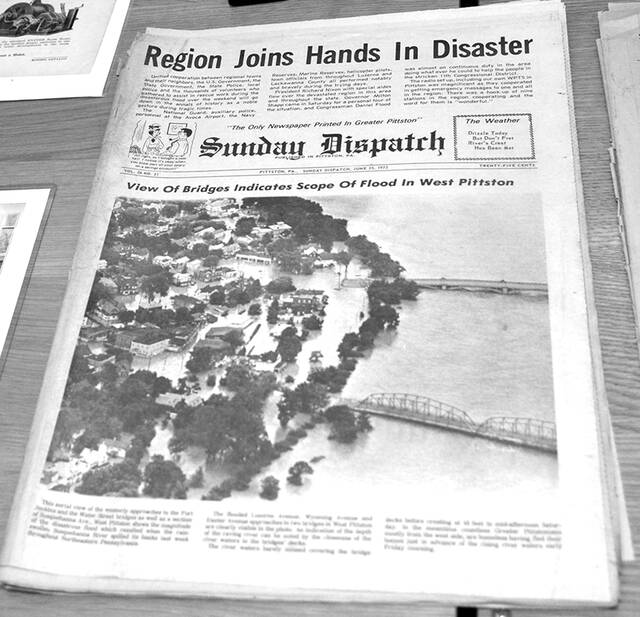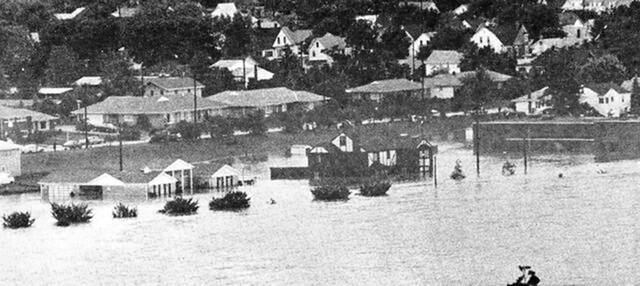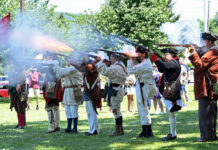
Shown is a Sunday Dispatch from June 25, 1972, just days after the Agnes Flood that devastated West Pittston and the entire Wyoming Valley.
Sunday Dispatch file photo
The following is a retrospective written by Tony Callaio on the 48th anniversary of the Flood of ’72.
WEST PITTSTON — It’s hard to believe 48 years have passed since the wettest cyclone on record literally destroyed Wyoming Valley by dumping seven to 10-inches of rain over Northeastern Pennsylvania alone. Parts of western Schuylkill Country received as much as 19 inches in total.
Hurricane Agnes flooded every town from Falls to Bloomsburg on both the eastern and western shores of the Susquehanna River in June of 1972. It was reported the Square at Wilkes-Barre was under 14-feet of water and the entire town of Kingston was inundated except for a few homes.
The valley suffered mass destruction including the Forty Fort Cemetery when 2,000 caskets were washed away. Human remains were discovered all over the Forty Fort and Kingston areas.
Thousands were evacuated from their homes and hundreds of others were stranded and rescued by boat. It was estimated over 25,000 home and businesses were destroyed or damaged by floodwaters. Luzerne County’s losses totaled $1 billion. If a flood of Agnes’ magnitude happened today, with today’s inflation rate that would total over $6.2 billion.
As a 14 year old teen, witnessing the storm and the aftermath of destruction was mind-blowing.
One of my many vivid memories of that third full week in June was the rain. Up until that point in my life, I had never seen so much rain and even though the rain was astonishing, what I recall the most is how fast and furious were the downpours.
On average, you can get caught in a downpour and they never last very long. If you’re stuck in your car during a heavy rain, you just might sit there and wait for it to pass. That wasn’t the case during Agnes, rained so hard for so long, you felt like the world was coming to an end. It was raining in biblical proportions.
On June 14, 1972, a tropical depression emerged in the western Caribbean Sea sustaining winds at 35 mph and a day later it was declared Tropical Storm Agnes. Two days later, Agnes picked up strength being named the hurricane of the season.
Agnes wasn’t the devastating hurricane you see as it picks up strength in the Atlantic Ocean heading towards mainland USA hitting Category 4 or 5, as a matter of fact, Agnes’ speeds never reached over 85 mph.
As Agnes traveled north from the Gulf of Mexico, it scooted over land, reducing it back to tropical storm status by June 19 after hitting landfall near Panama City, Fla.
The twist came when Tropical Depression Agnes re-strengthened over the eastern North Carolina shores of the Atlantic Ocean continuing a path towards New York City making landfall at 1 p.m. on June 22. Agnes was then upgraded back to a tropical storm.
On June 24, the National Hurricane Center issued a statement that Tropical Storm Agnes an extra tropical cyclone was over NEPA.
With all the rain that NEPA sustained coupled with the rain received in upstate New York, at the origin of the Susquehanna River, the river basins began to rise.
Agnes began on June 14 and ended on July 6, taking a total of 128 lives. It created a total of $2.1 billion in damage along its path, where it was estimated 70% of that cost was to the Wyoming Valley, leaving 5,000 acres of land affected in Luzerne County, according to the late college professor and filmmaker, Dr. Anthony Mussari. Mussari authored a book on the flood, “Appointment with Disaster.”
On the evening before the Susquehanna River overflowed its banks in West Pittston, a marathon basketball game was being held at the Wyoming Area High School gym. I told my parents would be attending the game and assured them I was staying all night.
At one point during the late evening hours, someone came in from outside explaining how the river was rising at a rapid pace never seen before.
Naturally my curiosity level peaked and I decided, umbrella in hand, to venture out to see what all the commotion was all about.
As I walked from Wyoming Avenue east on Montgomery Avenue, the closer I got to the riverbank, the activity level increased. Cars were driving all around looking for a parking spot so occupants could venture to the river’s edge. Hundreds of people were roaming around on Susquehanna Avenue.
Some people stopped dead in their tracks watching the river swiftly go by and homeowners on Susquehanna Avenue were manning a position on their property, leaving a tree branch or stick marking the water’s edge only to move it closer and closer to their home hour after hour.
I strolled up and down Susquehanna Avenue from the Armory to the Water Street Bridge and back dozens of times that evening. Each time noticing those same markers moving further back.
At one point, I was walking past the late Frank and Marilyn Schevets’ home on the corner of Susquehanna Avenue and North St. Mr. Schevets recognized me walking by, his son Frank, Jr. and I were West Pittston Little League teammates.
He asked me if I could give him a hand moving the front porch furniture to inside the house. I, of course, obliged and moved the furniture. Unfortunately, moving the furniture was futile as their entire basement and first floor was eventually flooded.
Instead of watching basketball all night, I witnessed the most incredible natural disaster that hit Northeastern PA.
When daylight occurred, the entire flooded area looked surreal, like it was out of a movie. Hundreds of homes in my town were affected and that was only the tip of the iceberg.
When the rains stopped and ravaging flood waters receded within its bank, the cleanup began.
The Colarusso family, Rose and her two children, Ron and Joy, were invited to stay with us while their Exeter Avenue home was being cleaned out from the mud and debris that flowed through their house.
If anyone you know lived through the 1972 Agnes flood will tell you how bad flood mud smelled especially as the summer heat baked it dry. It’s an odor that still lays present in my memory. It was everywhere.
At the time of the flood, College Misericorida was base camp for many that need to be rescued that didn’t have housing provisions. Helicopters were flying over Wyoming Valley were a normal scene for months. A stretch of Wyoming Avenue was open from West Pittston to the Midway Shopping Center but you couldn’t really travel much at all.
Our area was declared a natural disaster and the second flood occurred, now made of water, but of the National Guard. Even if you could travel, you were not allowed to go anywhere. A strict curfew was put into place for what seemed like forever.
Those not directly affected by flooding soon became volunteers to help those that were. I can’t begin to tell you how many homes and businesses I aided with cleanup.
If I thought West Pittston was a bad scene, I was wrongly mistaken. Forty Fort and Kingston, along with Wilkes-Barre looked like bombed out towns from a World War.
When we were finally allowed to drive and Wyoming Avenue, Rt. 11, was cleared of mud and debris, we traveled to Wyoming Seminary Upper School in Kingston to aid in clean up. What struck me the most was looking at mounds and mounds of furniture, carpet, plaster and drywall from interior walls, office furniture and equipment that lined Wyoming Avenue. It looked like we were driving in the middle of a canyon.
Since my friend was a student/athlete, when we got to the school, we focused our attention on gym and pool area.
Another surreal view was the gym floor. It was warped into dozens of mounds like a ski slope mogul run and it all had to be torn out by heavy equipment.
When we went to the pool area, there was mud everywhere coving the blue floor to the point you couldn’t see the floor at all. The pool itself was drained and tons of mud settled to the bottom.
Several of us hosed and squeegeed out mud for hours and it never felt like it was going to end, and yes, the smell permeated into my skin, my pores and my nose.
It took months and months to recover from the Agnes flood before things became somewhat normal. The events of 1972 seem similar to our current pandemic state. When you are in the moment, you never think things will get back to normal, but they did then and they will for us now.
It took time and patience and perseverance to bring the Valley with a Heart back to life again, but we did.





